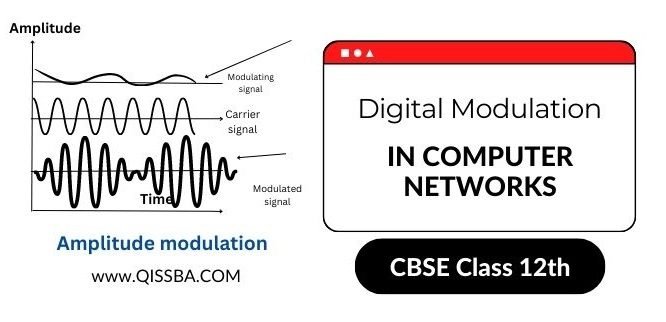
Digital Modulation in Computer Networks | CBSE Class 12
You have read that some waves from the electromagnetic spectrum, like radio waves and microwave etc. are used for carrying data or messages. How these waves carry messages, is the result of a particular technique called modulation. Modulation is a process of changing the characteristics of the wave to be transmitted i.e. the carrier wave by super- imposing the message signal on a high-frequency signal.
Modulation Process
A carrier wave by itself doesn’t carry much information that we can relate to (such as speech o data). To include a message (i.e. data or speech or image etc.) another wave a message signal that carries the data to be transmitted, need to be imposed on top on top of the carrier signal. This process is termed as modulation. Modulation alters the shape of a carrier wave to encode somehow the speech or data information that is to be carried. Now this encoded form of wave (i.e. the speech/data merged with the carrier) will be transmitted. Thus, you can say that modulation is like hiding a code inside the carrier wave. Figure 11.1 shows you the meaning of modulation.
The main function of the carrier wave is to carry the audio or video signal from the transmitter to the receiver wave results into a new wave called the modulation wave.
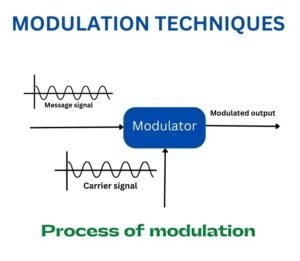
Major types of digital modulation
Modulation is a technique in which some characteristic of a carrier signal is varied in accordance with a message signal. Two major techniques of modulation work with two basic properties of waves: amplitude and frequency.
- Amplitude.
The amplitude of a weave is its maximum disturbance from its undisturbed position. It is measured in the form of the height of the wave.
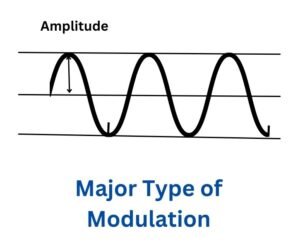
- Frequency.
The frequency of a wave is the number of waves produced by a Source, per second. It is measured as the number of waves that pass a certain point in one second.
When these two important properties of waves are altered, it results in two major types of modulation techniques :
- Amplitude modulation
- frequency modulation
Amplitude Modulation (AM)
Let us first try to understand amplitude modulation in simple words. As you know that amplitude is the height of the carrier wave, if somehow, you can tweak the height of the carrier so that it shows the impact of data/message signal. For example, if an input signal’s height varies with the loudness of a user’s voice and then adds this to the carrier, then the carrier’s amplitude will change corresponding to the input signal that’s been fed into it. This is called amplitude modulation or AM.
Following figure (fig.11.2) explains the process of amplitude modulation.
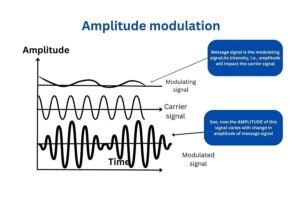
So amplitude modulation is the technique in which the amplitude of the carrier signal is varied in line with the variations in the intensity of the modulation signal, i.e. the message and the resultant signal is the modulation signal (amplitude to carry the actual message. Please note that the other characteristics of the carrier wave (frequency, phase etc.) remain unchanged.
frequency modulation (FM)
Just as the amplitude gets varied as per the input message signal in amplitude modulation, the frequency of carrier signal can also be changed as per the input signal. If this input signal is added to the pure carrier wave, it thereby changes the frequency of the carrier wave. In that way, users can use changes of frequency to carry wave the message information. This is called frequency modulation Or FM.
Following figure (fig.11.3) explains the process of frequency modulation
With frequency modulation, the frequency of the carrier wave is shifted proportionally to the intensity of the modulation signal. Therefore, the frequency of the modulated wave is shifted continuously. Please note that the other characteristics of the carrier wave (amplitude, phase etc.) remain unchanged.
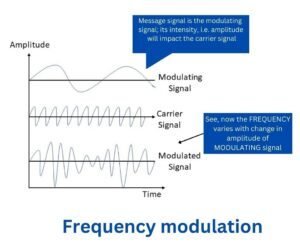
As it must clear to you by now that :
- It is the amplitude of the message signal or the modulation signal that impacts both the modulation techniques.
- If the AMPLITUDE of the carrier wave is varied as per the message signal keeping other characteristics intact, it is the AMPLITUDE MODULATION.
- If the FREQUENCY of the carrier wave is varied as per the message signal keeping other characteristics intact, it the FREQUENCY MODULATION.


